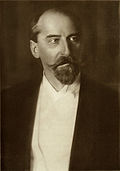This article needs additional citations for verification .(January 2022) |
The State Elder (Estonian : riigivanem), sometimes also translated as Head of State, was the official title of the Estonian head of state from 1920 to 1937. [1] He combined some of the functions held by a president and prime minister in most other democracies.
Contents
- List of state elders of the Republic of Estonia
- 1920–1934
- 1934–1937 (acting)
- See also
- Notes
- References
According to the 1920 Estonian Constitution, which was enforced by the "Constitution of the Republic of Estonia, the Referendum Act and the Citizens’s Initiative Act Implementation Act" on July 2, 1920, after being approved by the Constituent Assembly on June 16, 1920 (Riigi Teataja August 9, 1920 No. 113/114), the Government of the Republic consisted of the riigivanem (State Elder) and Ministers (Section 58).
The responsibilities of the State Elder were representing the Republic of Estonia, administration and co-ordination of the activities of the Government of the Republic, chairing the Government meetings; the State Elder had the right to make inquiries about the activities of the Ministers (Section 62). The Government of the Republic appointed one of its members the Deputy of the Elder of State.
In practice, the State Elder had very little power. The 1920 constitution was radically parliamentarian in character, and the State Elder could be voted out of office at any time. This limited his ability to play a balancing role between the government and the legislature.
With the 1934 constitution, the institution saw a reform and it became the equivalent of a president only as a separate head of government was to be elected. The 1934 coup by Konstantin Päts resulted in the institution never coming to real life as he ruled as the Prime Minister in Duties of the State Elder until 1937.








